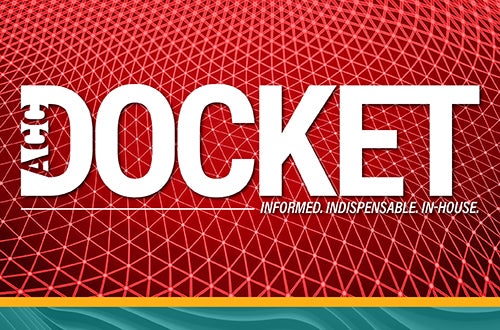What to do Before, During and After a Crisis
Crises are inevitable. They are a fact of business today. In fact, a recent report from The Economist found that executives today have an estimated 82 percent chance of facing a crisis in any five-year period, up 20 percent from two decades ago. The manner in which an organization communicates during a crisis can have enormous influence on how it is perceived in the future, and that perception can have a demonstrable impact to the bottom line. But, reputation risk - now the fourth highest risk concern of executives globally, above failure to innovate and failure to meet customer needs - can be mitigated. In today's 24/7 social media environment, there is little time to react when a crisis hits, but with the right preparation, in-house counselors can help their organizations respond quickly and effectively - necessities when preserving reputation.
Here are 10 tips to create a comprehensive crisis communications plan:
Building your plan...
1. Identify risk areas
Before diving into the creation of a crisis communications plan, it is important to have a clear idea of what your company will be up against. You need to understand the field of potential reputational risks before you can develop communications assets that will help you weather them.
Begin by thinking about issues that can affect your company's operations and industry issues as well as broader crises that can affect all businesses or your larger community. There are crises universal to many businesses: natural disasters, personnel issues or large-scale layoffs. But, what is specific to your organization and industry? For example, a food manufacturer may need to prepare draft statements or talking points in anticipation of a health or safety risk, whereas a financial services company may need to higher prioritize developing communications templates for managing a cyber security threat.
One thing about a crisis you can count on - it will have a way of surprising you. A clearly defined set of risk areas, put into heat maps or other hierarchal charts, can help companies best plan against and respond when issues arise, especially when forced to field media requests or incoming employee questions. While no one can generate a complete list of possible crisis events, reasonably anticipating a comprehensive spectrum of issues will give you the opportunity to craft foundational assets that use can use and tailor to communicate during even the most surprising events.
2. Understand and prepare for the power of communications
Many companies may incorrectly assume that a business continuity plan is all that is needed when a crisis hits. But, miscommunicating - or failing to communicate - can exasperate an issue or even start a new one. Companies need to be prepared to quickly respond to the media, but arguably even more important, organizations need to plan how and what they will communicate to their entire breadth of stakeholders: employees, customers, the market, suppliers, etc. In today's environment, it only takes one vocal source - whether an employee, local reporter, activist, concerned community member or Twitter profile - to start a media firestorm. Templates - meaning draft standby statements, employee memos, customer communications, and even social media posts - with approved, consistent language that address each reputational risk your team has identified (with areas for customization to address reality's unique quirks) will go a long way to preparedness.
For example, imagine an employee is injured while on your premises. Just like you can reasonably assume there are operational protocols that will need to be followed, you can anticipate likely key messages that will need to be shared with your stakeholders - e.g., other employees.
Organize these templates into a communications plan that is easily accessible to those who will need to use them. An unwieldy plan that is not reviewed regularly can dramatically slow reaction time, allowing for others to tell the story for you, while a thorough crisis communications plan that complements business continuity can minimize damage, nurture healing and facilitate an expedited return to normal operations.
3. Clearly define roles now
In addition, clearly define the roles of the crisis response team now and assign the specific facets of communications to team members. Like with all other aspects of crisis management, too much time could be lost defining communications responsibilities in the moment. Determine who is doing what, with whom they will work and what resources they may need to tailor, approve and distribute various forms of communications is key.
Establish who is in charge, who is approved to authorize messages and when. For example, who has the authority to edit a message? Who has access to your company's intranet for distributing updates, if that's the channel you choose? Is there a centralized data base of customers and who owns the outreach to them should a crisis require it?
It is also incredibly important to identify spokespeople and ensure they're trained to be camera-ready. Drill these team members regularly on their roles to ensure fast, accurate responses when a crisis hits.
Often, the best solution allows you to leverage the talents of multiple teams: The communications team - potentially consisting of the legal and public affairs departments - should be able to serve as the principle advisors on all matters related to internal and external communications. Business leadership should work with the communications team to assess the situation, make high-level decisions and approve communications. And, a panel of issue experts, ranging from HR executives to safety or operation heads depending on the nature of the situation, can add nuance and color to communications based on the specifics of a crisis.
4. Drill, drill drill!
A solid communications plan is nothing if the important players do not know how to use it. Take the time to hold regular drills of relevant crisis scenarios to ensure your communications templates and processes for message distribution work seamlessly when a "real-life" crisis hits. Often, going through the motions will reveal vulnerabilities that were not anticipated.
After drilling on communications process, drill your spokespeople on speaking with the media. Media training is an essential aspect of the crisis communications response. Along with communications representatives, company leadership should also be prepared to go in front of the media - or employee groups, customer contacts, local community members - in certain scenarios.
Make necessary changes after training teams, and then train again.
Putting your plan into action...
5. Speed
There are four guiding principles that should help inform your communications in the event of a crisis: The first is speed. One of the main functions of extensive crisis communications preparedness is to ensure speed of response when an issue hits. Thanks to today's 24/7, immediate news cycle, individuals have come to expect a new level of access to information in all industries or sectors; there is no longer a linear path of information to be shared or any intermediaries between a corporation and the public.
Social media has created real-time news reporting, and anyone can be a reporter. What was once a 24-hour window to respond has shrunk to what can feel like anything between minutes to 2 hours. Your organization must be ready to respond. Even if you don't have all the answers, acknowledging you are listening and seeking answers can buy a lot of time. More importantly, acknowledging the situation can quell angry sentiment and make sure your audience will be receptive to your messages as more information becomes available.
6. Accuracy
However, speed must be tempered with accuracy. In most cases, it's better to wait to get something right than it is to rush to a response. It is okay to say that you don't know certain pieces of information but that there is a plan to find them. You can couch updates to the public by defining them as "what we know at this time is..." If the spokesperson is not the best individual to respond to certain questions, let the media or audience know that you will need to get back to them, but then, make sure you do. Never speculate, and remember honesty is always the best policy.
7. Authenticity
When responding to a crisis, it's important that your organization not behave too differently than it did before the issue - or if it claims to have changed, it must actually change. Audiences, both internal and external, have little patience for inauthentic behavior or communication, and that only becomes truer under the spotlight of crisis. For example, an organization - after years of neglecting appropriate environmental practices - cannot claim to be a leader in environmental stewardship after an accident, unless it is making demonstrable changes, such as replacing leadership, committing an investment, changing policies, etc.
8. Empathy
The fourth and final principle is empathy. Even in situations where it is not appropriate to accept fault, it's still critical to communicate that you understand the impact the crisis has created. People need to hear you are aware of the affects you or the issue are having and you share their urgency to fix the problem. Let your audiences know that you care. And, remember a vital part of communication is nonverbal. In certain circumstances, no written statement in the news can replace the need for business leadership to go in front of a camera and address the situation head-on. Appeal directly to those affected, and tell them you will find the answers to who, what, when, where, why and how it will be fixed.
Improving the plan...
9. Debrief
After a crisis hits, take a step back. Ask yourself and your team: "What worked? What didn't work? Are there areas for improvement?" Just as crisis communications drills will reveal unseen vulnerabilities, so will the real thing - and often, those vulnerabilities will be magnified. This time after an event is crucial to protecting yourself for the next event. For example, were you lacking in redundancies for communicating to the same stakeholder group? Did you find not enough employees were reached via email and you now need to build a mobile alert system? Do you need an external conference line that operates independently of your company's systems, which may be impacted by the crisis? Ask all of the tough questions, and be prepared to answer them honestly.
10. Evolve
Your work isn't done when the news cycle changes. Implement any necessary changes to your plan. Externally, it's important to do what you said you'd do during the crisis. Hold crisis team members responsible for evolving your communications plans and resources - and keeping things up to date as a result of your learnings. Consider using real-world crisis examples as future drill topics to ensure your team is really evolving. And remember, as you are evolving, so too are the risks your company may face. Steps one to four should be repeated yearly, so your plan is most effective and accurate.

